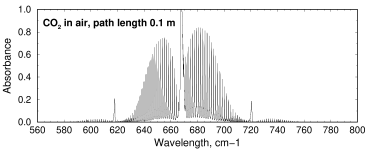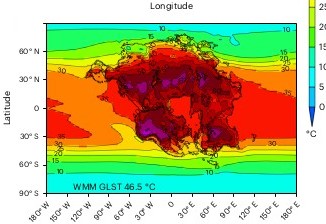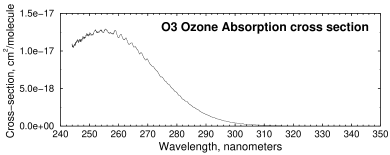 ight scattering is one of the most fascinating subjects in science. It
is why babies' unpigmented eyes are the same shade of blue as the clear
sky. It tells us about supernovas and stellar evolution.
If our eyes were a bit more sensitive in the near infrared, the night
sky would not be tiny points of light but a deep red carpet of vast,
intricately detailed clouds of ionized hydrogen that cover half the
visible sky. Leave it to humans to focus on global warming, the dullest
and most politicized aspect of optics.
ight scattering is one of the most fascinating subjects in science. It
is why babies' unpigmented eyes are the same shade of blue as the clear
sky. It tells us about supernovas and stellar evolution.
If our eyes were a bit more sensitive in the near infrared, the night
sky would not be tiny points of light but a deep red carpet of vast,
intricately detailed clouds of ionized hydrogen that cover half the
visible sky. Leave it to humans to focus on global warming, the dullest
and most politicized aspect of optics.
For years climate studies researchers have traded on the credibility of science to prop up the theory that human-generated carbon dioxide is causing a “crisis.” The news media love a crisis, so they repeat the scary claims and speculative predictions from these researchers as if they were scientifically established facts.

Carbon dioxide absorbance spectrum in the 15 μm band shows a large number of transition lines that contribute to absorption. Path length 0.1m, concentration 1%. Data source: Hitran. Converted from transition lines to Lorentzian peaks by HAPI2
Rule #1 in science is that we must demonstrate our conclusions empirically using physical evidence, not by speculation. Take smoking: researchers suspected deaths from lung cancer were caused by smoking. Speculation was not sufficient; if the effect was real, it had to be a dose-dependent response with an age-matched control group, and this was demonstrated with reasonable confidence.
If you must speculate, you have to label it as such. Here's how it should be done, from the first edition of Radiative Transfer in the Atmosphere and Ocean by Gary Thomas and Knut Stamnes[1]:
The observed increase in the mean temperature of the Earth by ≈0.5°C since 1900 suggests that the rise in CO2 from 200 to 240 parts per million may be partly responsible. [Italics added]
How on Earth did we get from this wonderful collection of qualifiers and speculative weasel words to banning all viable sources of energy and risking extinction by geoengineering our climate to solve the ‘crisis’? The authors even came up with a nice formula that expresses their speculation in math terms. But speculating with math is still speculating.
Admittedly, scientists often run up against page limits and reviewers who demand that we take out all those weasel words. But they're essential for honest communication.
How does CO2 absorb light?
CO2 can interfere with light by scattering it and by absorbing it. CO2 absorbs radiation because bending a CO2 molecule changes its dipole moment, turning it into an electric dipole. CO2 molecules rapidly redistribute their energy, either by elastic collisions with other gases or by re-radiating it in a different direction. Some other molecules, like H2O, are asymmetric and so have a permanent dipole moment. This causes them to rotate when hit with a photon, and they absorb strongly in the microwave region.
How do absorption and scattering differ? Absorption occurs when radiative energy is converted to an excited state. When an excited molecule releases its absorbed energy by re-emitting it, it is called scattering. Scattering is very complicated. The scattered photons may have different wavelengths, directions, and polarizations than the incident photons. The alternative is to release the energy through collisions.
Whether scattering or collisional de-excitation is faster depends on the wavelength and the environment of the molecule. For CO2 in the atmosphere at 15 μm, it takes 10−5 seconds to collide and 0.1–1 second to radiate, so collision is the predominant mode up to at least 75 km altitude. This means the energy is mainly transferred from CO2 by bumping into oxygen and nitrogen molecules.
Can global warming ever be proven?

CFC-13 (CF3Cl) absorption in the infrared. IR absorption and emission spectra of gases consist of large numbers of closely spaced lines, while thermal emission from solids is a smooth continuum. Data source: Hitran
The challenge science faces is that the observed warming (assuming, of course, that we can trust the data) is at best one degree over a diurnal, geographical, and seasonal background a hundred degrees bigger in a system with powerful compensatory mechanisms. So we're looking at a tiny signal in a complicated system that is one or two orders of magnitude below the noise.
This raises two questions: first, are any of these changes statistically significant? And second, how would one test the AGW theory? Here's what has been tried.
Simple experiments: Set up an infrared source and detector in an evacuated tube. Add a known amount of pure CO2 and measure how it affects the signal. If you do the experiment correctly, you can demonstrate that CO2 can absorb specific wavelengths of infrared radiation. Even these experiments aren't trivial (for instance, you have to ensure thermal equilibrium and rigorously exclude water).
Computer models: Models are good for only two things: to generate hypotheses and to do a sanity check on a theory. No model can ever prove or disprove a theory. Take the theory of relativity. If the only evidence we had for it was a computer model, we would say it is still unproven. A good numerical model requires not just expertise and scientific skill, but ruthless honesty which, based on some of the papers I've read recently, seems to be in short supply. But no matter what, a model can never prove anything.
It's sometimes claimed that a computer model can make predictions that can then be tested. It was found that these experiments are insanely difficult because a large number of variables can affect the result.
If a model predicts both more and fewer storms, more and less snow and ice, and more and less rain, or if it predicts huge numbers of unrelated phenomena from poor quality wine to more butterflies, the model is useless because predicting everything and its opposite is by definition unfalsifiable.
Precautionary principle: Assume that if the theory is true it could be a problem, so play it safe and act as if it is true. The problem here is that the precautionary principle is half of a risk-benefit analysis. It ignores the real possibility that taking some action could make the problem worse.
Secondary effects: Measure things like ocean acidity and sea ice extent. If you dig deep enough in the literature, you can find some good science here. But at best it can hint that the Earth is slightly warmer; it says nothing about why.
Any sufficiently bad science is indistinguishable from a hoax

Speculation with a computer The authors of one paper used a global warming model to predict that land mammals will become extinct in 250,000,000 years due to global warming. Volcanoes, they say, will raise pCO2 and the sun will get brighter by 2.5%. The authors assert that this pushes us past a “tipping point” so when CO2 gets between 410 and 816 ppm, mass extinction is all but assured. The computer may be right or it may be wrong, but whatever it's doing, it's more like a what-if scenario than hard science. Image source: [2]
For some good examples, see this article.
An essential part of good science is to distinguish what we know from what we think will happen. This is seen in rigorous science textbooks, like the one mentioned above. We are thus entitled to ask: Is it good science to predict a billion human deaths from one degree of warming? Or to claim that 99% of scientists agree with you when your own data show that the number is actually 30%? Is it good science to claim that there will be global warming and mass extinctions—in 250 million years after Pangea re-forms and that this means it's a crisis now?
The answer to all these questions is no. The truth is that we don't know whether AGW is too small to bother with or too big to ignore. Little wonder some people think it's all a hoax.

Ozone absorption in the ultraviolet. Each UV photon that hits an O3 molecule destroys the molecule, generating molecular oxygen (O2). Ozone also absorbs outgoing infrared at 9.6 μm, so depletion of the ozone layer is said to cause global cooling. Data source: Hitran
Last week I got into a discussion with a climate skeptic who was convinced that 400 ppm was such a low concentration that photons would pass right through the atmosphere without ever striking a CO2 molecule. A simple calculation shows this idea to be mistaken: if all the atmospheric CO2 were concentrated in one layer at a pressure at STP (1 atmosphere, standard temperature and pressure), it would be a layer about 40 meters thick. Ozone, at less than 15 ppm, is even rarer. Yet despite the fact that each UV photon destroys an ozone molecule, almost no shortwave UV below 280 nm gets through.
Many of these skeptics are non-scientists and naturally will make errors. The news media can't be blamed either: inventing crises out of thin air is their business model. But in the end, whichever side is the least unscientific will eventually win the argument. So far, the score is a dead heat: zero to zero.
The Experiment
Climate studies are not exempt from the need for scientific proof. If you want to claim that CO2 causes warming, then prove it. Here's one experiment that might work: a blinded crossover design as is done in clinical drug trials.
Build four identical biodomes, big enough to have clouds and a complete weather system. Put trees inside but no animals or humans. (And no SUVs.)
Fill one with CO2 to 200 ppm, one with 400 ppm, one with 600, and one with 800. This would give four data points, enough for a statistical test of linearity. Measure the CO2 in each dome to make sure it remains constant. Make it blinded so that no one knows which is which until after the data are analyzed.
Measure the temperature in each dome at 1000 different points over a period of five years. The domes would need strict security to prevent activists from interfering.
Reverse the order so the domes are now 800, 600, 400, and 200 ppm and repeat the experiment. This is an essential control to correct for factors like unknown differences among the domes or malfunctioning sensors.
This will tell us how much warming CO2 causes and whether it's ‘dose’-dependent, linear, or saturated. It won't tell us whether it's harmful or beneficial. It may be expensive, but if the goal is to convince skeptics and fellow scientists (as opposed to intimidating people into silence), experimental evidence will be essential.
Compared to the estimated multi-trillion dollar cost of “net zero,” all for the sake of an untested hypothesis, the cost of this experiment would be trivial.
Conclusion
Without doing an empirical test, we can see from the ozone hole story how this will play out. This year, 36 years after the Montreal Protocol, the ozone hole is as big as ever. Yet no one dares to doubt that without the Protocol the hole would be even bigger. Likewise, if destroying the carbon economy should have no effect on GW, the warmers will convince themselves that the warming would be even worse if they had not done so. But if their attempts to stop AGW should launch a catastrophic ice age, and too few scientists warned of the risks of speculation that's being done in our name, they will blame science.
So let's do a definitive experiment and put an end to all this speculation. Then we can all go back to something more important, like finding Bigfoot and worrying about UFOs.
[1] Thomas GE, Stamnes K (1999/2002) in Radiative Transfer in the Atmosphere and Ocean. Cambridge University Press
[2] Farnsworth A et al. (2023). Climate extremes likely to drive land mammal extinction during next supercontinent assembly. Nature Geoscience 16, 901–908
oct 16 2023, 6:44 am. last updated oct 18 2023, 4:27 am
